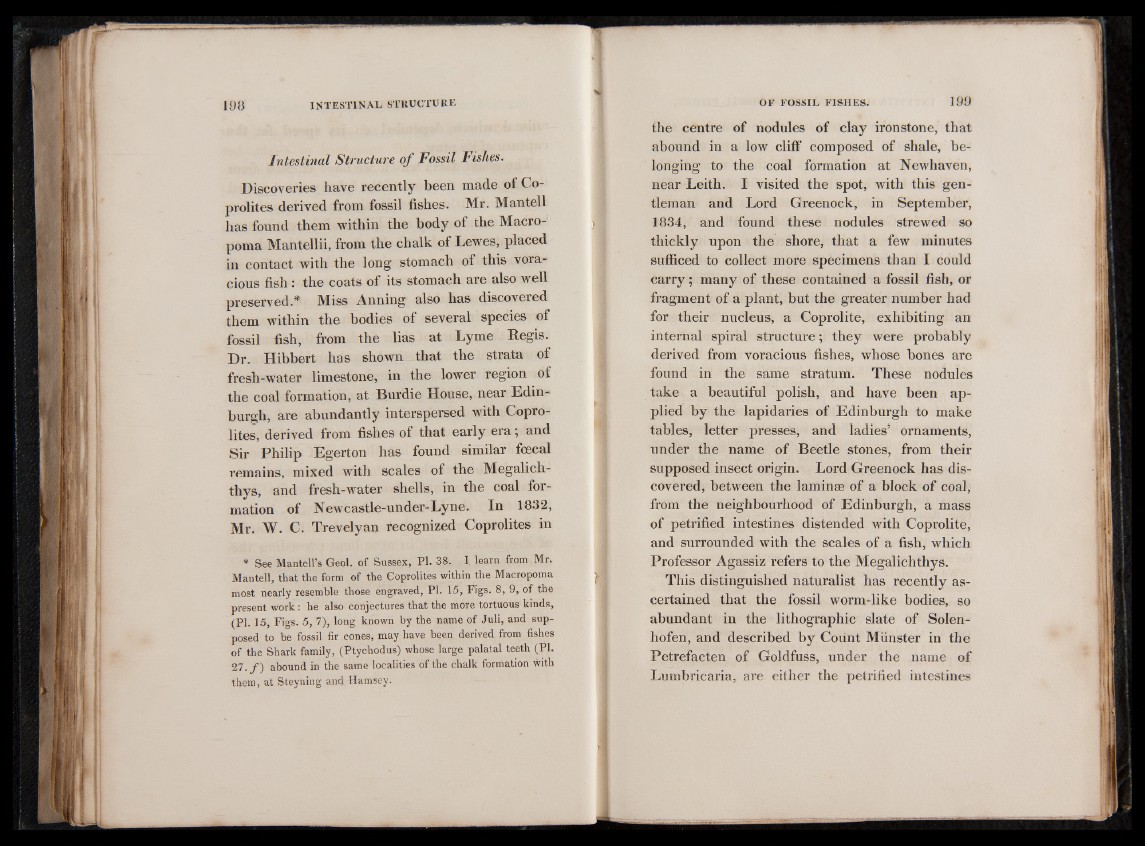
Intestinal Structure o f Fossil Fishes.
Discoveries have recently been made of Co-
prolites derived from fossil fishes. Mr. Mantell
has found them within the body of the Macro-'
poma Mantellii, from the chalk of Lewes, placed
in contact with the long stomach of this voracious
fish : the coats of its stomach are also well
preserved.* Miss Anning also has discovered
them within the bodies of several species of
fossil fish, from the lias at Lyme Regis.
Dr. Hibbert has shown that the strata of
fresh-water limestone, in the lower region of
the coal formation, at Burdie House, near Edinburgh,
are abundantly interspersed with Copro-
lites, derived from fishes of that early era ; and
Sir Philip Egerton has found similar foecal
remains, mixed with scales of the Megalich-
thys, and fresh-water shells, in the coal formation
of Newcastle-under-Lyne. In 1832,
Mr. W. C. Trevelyan recognized Coprolites in
* See Mantell’s Geol. of Sussex, PI. 38. I learn from Mr.
Mantell, that the form of the Coprolites within the Macropoma
most nearly resemble those engraved, PI. 15, Pigs. 8, 9, of the
present work : he also conjectures that the more tortuous kinds,
(PI. 15, Figs. 5, 7), long known by the name of Juli, and supposed
to be fossil fir cones, may have been derived from fishes
of the Shark family, (Ptychodus) whose large palatal teeth (PI.
2 7 . / ) abound in the same localities of the chalk formation with
them, at Steyning and Hamsey.
the centre of nodules of clay ironstone, that
abound in a low cliff’ composed of shale, belonging
to the coal formation at Newhaven,
near Leith. I visited the spot, with this gentleman
and Lord Greenock, in September,
1834, and found these nodules strewed so
thickly upon the shore, that a few minutes
sufficed to collect more specimens than I could
carry; many of these contained a fossil fish, or
fragment of a plant, but the greater number had
for their nucleus, a Coprolite, exhibiting an
internal spiral structure; they were probably
derived from voracious fishes, whose bones are
found in the same stratum. These nodules
take a beautiful polish, and have been applied
by the lapidaries of Edinburgh to make
tables, letter presses, and ladies’ ornaments,
under the name of Beetle stones, from their
supposed insect origin. Lord Greenock has discovered,
between the laminae of a block of coal,
from the neighbourhood of Edinburgh, a mass
of petrified intestines distended with Coprolite,
and surrounded with the scales of a fish, which
Professor Agassiz refers to the Megalichthys.
This distinguished naturalist has recently ascertained
that the fossil worm-like bodies, so
abundant in the lithographic slate of Solen-
hofen, and described by Count Münster in the
Petrefacten of Goldfuss, under the name of
Lumbricaria, are either the petrified intestines